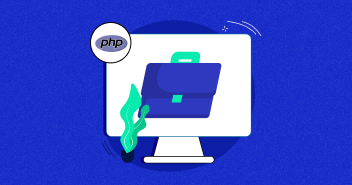At the time of writing this article, the most recent version of Symfony is 3.3.6. The community is abuzz with the news of imminent release of Symfony 4.

In many of my previous articles, I have covered Entity Managers and Doctrine in Symfony. The tutorials have covered the process of generating and configuring entities in Symfony. Now a common scenario in real world Symfony projects is the requirement of working with multiple databases. In many cases, the project requires access to two or more databases simultaneously for Doctrine related actions. I will cover this topic in this tutorial.
For the purpose of this tutorial, I am assuming that you have already installed Symfony on Cloudways and that it’s running properly in the browser.
The Traditional DB Config
While installing Symfony on Cloudways best PHP hosting, the Symfony Installer asks questions about the database credentials:

Note: You can get your Cloudways DB credentials in Application access area of the Cloudways Platform.
The following credentials are available in the parameters.yml file:
parameters: database_host: 127.0.0.1 database_port: null database_name: qmsfumgabd database_user: qmsfumgabd database_password: xxx9bxxMxx mailer_transport: smtp mailer_host: 127.0.0.1 mailer_user: null
Here are the details about the default connection and credentials in the config.yml file:
# Doctrine Configuration doctrine: dbal: driver: pdo_mysql host: '%database_host%' port: '%database_port%' dbname: '%database_name%' user: '%database_user%' password: '%database_password%' charset: UTF8 orm: auto_generate_proxy_classes: '%kernel.debug%' naming_strategy: doctrine.orm.naming_strategy.underscore auto_mapping: true
When you create entities and call the getManager() function, you will get the default connection (that you used while installing Symfony). If you wish to bypass this traditional database setup and wish to use a different or multiple databases in your Symfony projects, you have two options. You could define it in the parameters.yml and then configure it in the config.yml. The second option is to directly define it in config.yml.
You might also like: Using Symfony Flex On Cloudways For Symfony Application Management
Configure Multiple Databases
I will start with the adding parameters to parameters.yml file. The second database connection could be added using the following parameters:
Parameters: # First database database_host: 127.0.0.1 database_port: null database_name: qmsfumgabd database_user: qmsfumgabd database_password: xxx9bxxMxx # Second database database2_host: 127.0.0.1 database2_port: null database2_name: huscqxzwaw database2_user: huscqxzwaw database2_password: dxxxFXxxxB
The next step is to get these credentials in the config.yml:
doctrine: # Configure the abstraction layer dbal: # Set the default connection to default default_connection: default connections: default: driver: pdo_mysql host: '%database_host%' port: '%database_port%' dbname: '%database_name%' user: '%database_user%' password: '%database_password%' charset: UTF8 database2: driver: pdo_mysql host: '%database2_host%' port: '%database2_port%' dbname: '%database2_name%' user: '%database2_user%' password: '%database2_password%' charset: UTF8
I have added a default connection default_connection: default with no connection specified in the entity manager method. Next, I distributed the configuration of the connections into ‘default’ and ‘database2’.
You might also like: Configure Elasticsearch In Symfony 3.X Applications Using FOSElasticaBundle
Finally, I will specify the mapping of each bundle in the project:
# Configure the ORM orm: default_entity_manager: default entity_managers: # Register which bundle should use which connection default: connection: default mappings: AppBundle: ~ DemoBundle: ~ database2: connection: database2 mappings: CloudwaysBundle: ~
At this point, the first option is complete. I will now describe the second method in which I could directly add the database credentials in the config.yml:
doctrine: # Configure the abstraction layer dbal: # Set the default connection to default default_connection: default connections: default: driver: pdo_mysql host: localhost port: null dbname: qmsfumgabd user: qmsfumgabd password: xxx9bxxMxx charset: UTF8 database2: driver: pdo_mysql host: localhost port: null dbname: huscqxzwaw user: huscqxzwaw password: dxxxFXxxxB charset: UTF8
The rest of the ORM settings will remain the same.
Now, I can call the entity manager in the controller by just calling it by name:
class UserController extends Controller
{
public function indexAction()
{
// All 3 return the "default" entity manager
$em = $this->getDoctrine()->getManager();
$em = $this->getDoctrine()->getManager('default');
$em = $this->get('doctrine.orm.default_entity_manager');
// Both of these return the "database2" entity manager
$anotherEm = $this->getDoctrine()->getManager('database2');
$anotherEm = $this->get('doctrine.orm.database2_entity_manager');
}
}
The following is the recommended syntax for repository calls, as mentioned in the Symfony docs.Similarly call the name of EM here also.
// Explicit way to deal with the "default" em $products = $this->getDoctrine() ->getRepository(Product::class, 'default') ->findAll() ; // Retrieves a repository managed by the "database2" em $customers = $this->getDoctrine() ->getRepository(Customer::class, 'database2') ->findAll();
If a specific entity manager is not called, `default` will be returned to the controller. To avoid errors, I will add `auto_mapping: true` to any one of the connection.
Once all this is done, when I am working with the schema and performing Doctrine actions, I will specify the connection name like this:
# For "default" mappings $ php bin/console doctrine:schema:update --force # For “database2” mappings $ php bin/console doctrine:schema:update --force --em=database2
Final Words
The best thing about Symfony is its very flexible structure that ensures that developers could easily mold the features of the framework to project specifications.
Remember that Cloudways offer one database per Symfony application. If you wish to use the second database, you have to launch the second application and use its DB’s credentials. In this scenario, remember that other configurations in the config.yml should not be affected.
If you have any question or queries, feel free to comment below.
Shahroze Nawaz
Shahroze is a PHP Community Manager at Cloudways - A Managed PHP Hosting Platform. Besides his work life, he loves movies and travelling.


